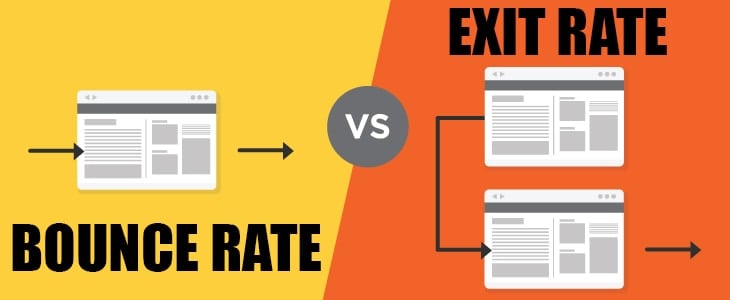- HOME
- CHECKOUT / CART
- LOGIN / REGISTER
- LINK BUILDING
- SEO
- OTHER SERVICES
- RESOURCES
- ABOUT
- About Us
- Why Us
- Testimonials
- INDUSTRIES
- Cannabis CBD Marketing and SEO
- Carpet Cleaning Marketing and SEO
- Cell Phone Repair Marketing and SEO
- Dental Marketing and SEO
- Drug Rehab Treatment Centers Marketing and SEO
- HVAC Marketing and SEO
- Junk Removal Marketing and SEO
- Law Firm Marketing and SEO
- Law Firm Website Design
- Medical and Healthcare Marketing
- Plastic Surgeons Marketing and SEO
- Plumbing Marketing and SEO
- Private Detectives / Investigators Marketing and SEO
- SaaS Marketing and SEO
- Strippers Marketing and SEO
- CONTACT
Bounce Rate vs Exit Rate Learn The Difference |

Bounce Rate vs. Exit Rate

In simple terms, bounce rate is the percentage of exits done by visitors without interacting or visiting another page on the website. On the other hand, the exit rate is the rate of how often the visitors left the site through a certain page.
Analyzing a website’s traffic is not a simple task. There’s a lot of factors to consider when gauging a website’s real performance. And when it comes to confusing metrics, both the bounce rate and the exit rate tend to trip up newcomers in the industry. Let’s find out more about these two rates and why they are important to know in managing a site.
What is An Exit Rate?
An exit rate is a metric used to measure how often visitors exit the website by leaving a specific page. It can be calculated as the total exits from a page over the total visits. The exit rate of each page is recorded regardless of the user’s interaction with other pages. It is often mixed up with bounce rate due to how similar Google defines both terms.
Bounce rate is a metric used to measure how many visitors land on a specific page and leave without interaction. You can calculate the bounce rate by dividing the total one-page visits by the total entrance visits.
For example, you have a website with four pages: Homepage, Products, Cart, and Checkout. Three sessions from three new visitors had happened like this:
- Visitor 1: Entrance > Homepage > Product > Cart > Checkout > Exit
- Visitor 2: Entrance >Homepage > Exit
- Visitor 3: Entrance >Homepage > Product > Exit
In this example, you can get the following information from the given sessions:
- Homepage: 3 views; 33% bounce rate, 33% exit rate
- Product: 2 views; 33% exit rate
- Cart: 1 view
- Checkout: 1 view; 33% exit rate
Only session 2 has a bounce rate because it is the only one left without interacting with other pages. On the other hand, each session has an exit rate on the checkout page, homepage, and product page. You can tell that one out of three sessions succeeded in getting sales by this information alone.
Bounce Rate And Exit Rate: What Is More Important?
Both rates are essential in getting the right analysis for your site. Exit rate, in particular, indicates what part of your conversion funnel is not working as intended. For instance, if a page that should encourage the user to go further down the conversion funnel has a high exit rate, this can mean that your conversion funnel is ineffective.
If you’re an online e-Commerce company, a high exit rate is preferable after the successful checkout landing page. This means that your visitors likely purchased from your store before leaving or hopping to another website. High exit rates on the homepage and product information page mean that users lose interest and are not motivated to move to the next funnel level.
On the other hand, the Bounce rate is essential in knowing the user’s satisfaction after using the site. A high bounce rate can either be good or bad, depending on what page gets the rating. Blogs preferably lean on the higher bounce rate for longer read times. Meanwhile, homepages and product information are better off with a lower bounce rate.
How To Reduce Exit Rate On Important Pages?
In most cases, a bad user interface and page design is the culprit of a high exit rate. You might want to remove the distracting pop-ups on these pages. Test the site navigation and determine if the flow is seamless. If in-page modifications don’t work, you might want to take a second look at your conversion funnel.
Our locations and Services:
Find us on Google maps for directions: Digital Marketing | SEO Las Vegas, Digital Marketing | SEO New York, Digital Marketing | SEO Phoenix, Digital Marketing | SEO Houston, Digital Marketing | SEO Atlanta, Digital Marketing | SEO Anaheim, Digital Marketing | SEO Alexandria, Digital Marketing | SEO Austin, Digital Marketing | SEO Calabasas, Digital Marketing | SEO Cleveland, Digital Marketing | SEO Corpus Christi, Digital Marketing | SEO Dayton, Digital Marketing | SEO Detroit,Digital Marketing | SEO Fort Worth, Digital Marketing | SEO Henderson, Digital Marketing | SEO Indianapolis, Digital Marketing | SEO Irvine, Digital Marketing | SEO Jersey City, Digital Marketing | SEO Knoxville, Digital Marketing | SEO Long Beach, Digital Marketing | SEO Los Angeles, Digital Marketing | SEO Medford, Digital Marketing | SEO Mesa, Digital Marketing | SEO New Orleans, Digital Marketing | SEO Palmdale, Digital Marketing | SEO San Jose, Digital Marketing | SEO Santa Clarita, Digital Marketing | SEO Santa Monica, Digital Marketing | SEO Scottsdale, Digital Marketing | SEO Sherman Oaks, Digital Marketing | SEO Seattle, Digital Marketing | SEO Tacoma, Digital Marketing | SEO Torrance

By placing an order, signing up for services from Marketing1on1 LLC or using this website you agree to Terms and Conditions and Privacy Policy
Copyright © Marketing1on1 LLC All rights reserved.
The content of this web site may not be copied, replaced, distributed, published, displayed, modified, or transferred in any form or by any means except with the prior permission of Marketing1on1 LLC.
Copyright infringement is a violation of federal law subject to criminal and civil penalties.
Blog | Accessibility Statement



